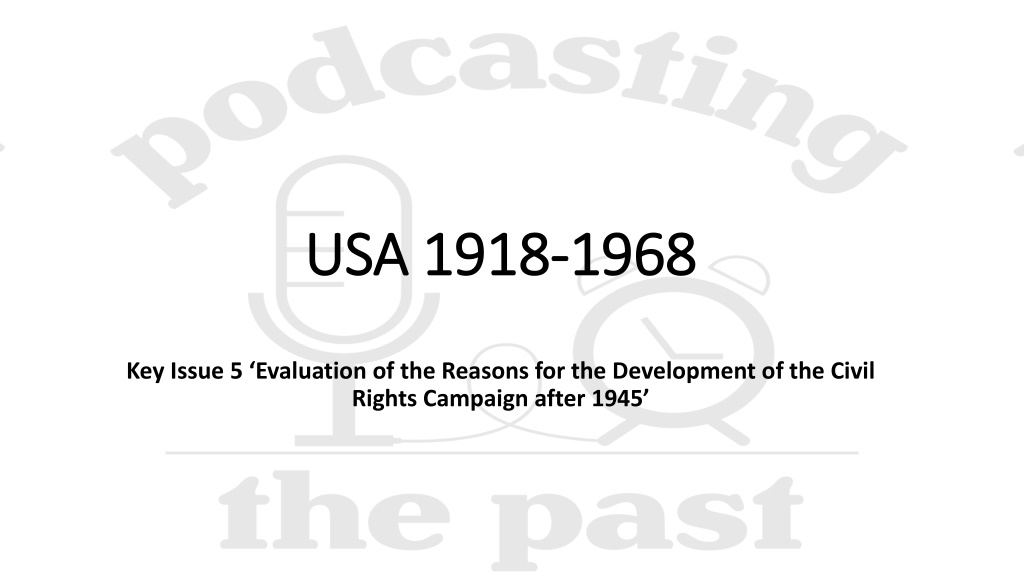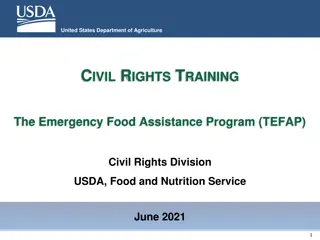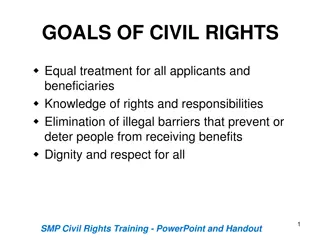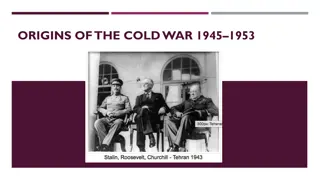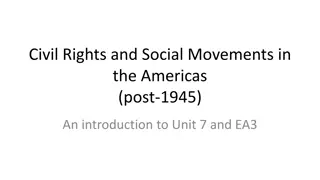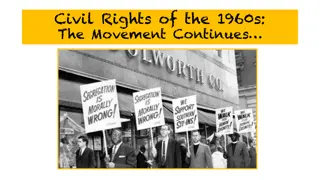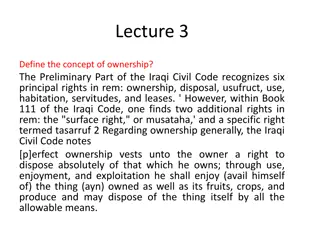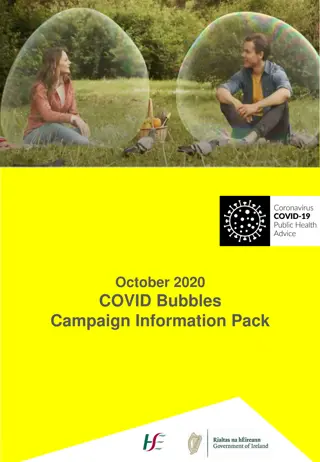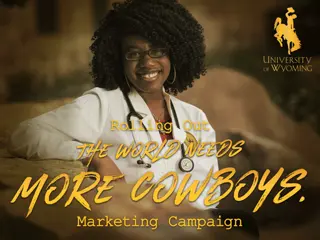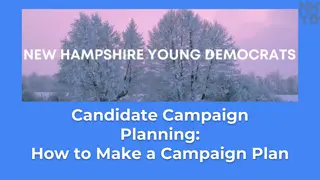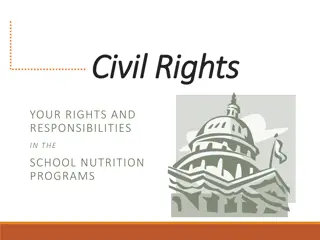Factors Influencing the Civil Rights Campaign in the USA After 1945
The civil rights campaign in the USA after 1945 was influenced by factors such as the continuation of prejudice and discrimination, the experiences of Black servicemen in WW2, the role of Black civil rights organizations, the leadership of Martin Luther King, and the emergence of effective Black leaders. Despite obstacles like lack of established organizations, individuals like WEB Du Bois and Marcus Garvey laid the foundation for the movement. The persistence of racial discrimination, highlighted by cases like Brown v. Topeka, fueled the demand for change and equality.
Download Presentation

Please find below an Image/Link to download the presentation.
The content on the website is provided AS IS for your information and personal use only. It may not be sold, licensed, or shared on other websites without obtaining consent from the author. Download presentation by click this link. If you encounter any issues during the download, it is possible that the publisher has removed the file from their server.
E N D
Presentation Transcript
USA 1918 USA 1918- -1968 1968 Key Issue 5 Evaluation of the Reasons for the Development of the Civil Rights Campaign after 1945
Factors 1. Continuation of prejudice and discrimination 2. Experience of Black servicemen in WW2 3. Role of Black civil rights organisations 4. Role of Martin Luther King 5. Emergence of effective Black leaders
Context A key obstacle faced by Black Americans in the campaign for equality was the lack of established organisations. Several individuals emerged throughout the 1920s who demanded change for Black communities, however, none were united in purpose. WEB Du Bois campaigned for equality for Blacks in every aspect of daily life. Marcus Garvey demanded a return to Africa and an affirmation of Black culture and pride. Some argue that the roots of the Black civil rights movement in the 50s and 60s came from the ideas of these individuals. In particular, WEB Du Bois group, the National Association for the Advancement of Coloured People (NAACP), which was established in 1909, tirelessly fought against the Jim Crow Laws in the early decades of the 20th century and was responsible for some of the most significant and highly publicised Civil Rights Campaigns of the post-war era. Furthermore, it could be argued that the 1960s marked a period of change for many Americans as it witnessed the move from previous acceptable social norms to the demand for change. After the end of World War Two the promise of a new world defined by peace and freedom jarred with the daily experiences of many Black Americans.
Continuation of Prejudice and Discrimination Background Background: In the USA in the 50s, Jim Crow laws still existed, and lynching went unpunished in many southern states. Violence, lynching and beating of Black people, which had declined since the 20s increased again after WW2. There was an increasing awareness of racial discrimination through the spread of television and news reporting of civil rights cases and lynching which went unpunished
Continuation of Prejudice and Discrimination Knowledge (K1) Brown V Topeka: 7-year-old Linda Brown was Black and the local school in Topeka, Kanas, was for whites only. Linda s father thought it was unfair that Linda should go to a school further away with less resources than the white school. (K1) With the aid of the NAACP, Linda Brown s father took the Topeka School Board to court. This was called Brown versus the Topeka Board of Education . (K1) Brown lost but appealed to the Supreme Court where they were successful. (K1) In May 1954, the Supreme Court overruled its previous decision that Separate but Equal was acceptable in education. To separate Negro children from others of similar age because of their race brings on a sense of inferiority that may affect their hearts and minds for the rest of their lives. We conclude that in the field of public education segregation denies Blacks equal protection under the law. Chief Justice Earl Warren, May 1954.
Continuation of Prejudice and Discrimination Continuation of Prejudice and Discrimination- - Knowledge Knowledge (K2) In 1955, Emmett Till, a 14 year old Black boy from Chicago went to visit family in Mississippi. Although the North was not free of racism, the South was much more dangerous for Black Americans. (K2) When in Mississippi, Till spoke to a female shopkeeper like he would in Chicago. Some say he wolf-whistled. As a result, he was dragged from his home and brutally murdered by the woman s husband and his friend. (K2) An all-white jury in Mississippi acquitted the killers. The court system in Mississippi was incredibly biased. (K2) The men later admitted their guilt in a TV interview.
Continuation of Prejudice and Discrimination- Knowledge (K3) In 1955, a 41-yearold Black woman, Rosa Parks, tired after working all day, was fined for refusing to give up her seat to a white man. She was sitting in the Black seats, but when all the seats became full, she was required by law to give up her seat to a white person and stand at the rear of the bus. She was arrested and fined $10. (K3) On the 5th December 1955, the local Black community supported her by staging a 24-hour boycott of the buses. Those who organised the boycott were a group called the Montgomery Improvement Association (MIA). They chose as their leader a 26-year-old, charismatic preacher from the Dexter Avenue Baptist Church, called Martin Luther King Jnr. The boycott was so successful that it continued for 13 months.
Continuation of Prejudice and Discrimination- Analysis (A1) This case was one of the first triggers that ignited the Civil Rights Movement in the 1950s. (A1) The Court s decision was the first victory for civil rights campaigners because the highest court in the country, whose job it was to decide what the constitution said, had decided that segregation in schools was unconstitutional. This gave civil rights campaigners great encouragement. (A1) However, this case only meant that schools should be desegregated, but the NAACP knew that if it took more cases to the Supreme court they would likely win. Eg. Transport. A+??
Continuation of Prejudice and Discrimination- Analysis (A2) The effect of the murder, and the failure to punish those accused, focused the attention of the US and and the world on the terrible injustice and violence that Black people faced in the South. (A2) The funeral. Attended by thousands am its publicity made Till s case a national event. (A2) His mother insisted he should have an open-casket in order for the world to see what the two men had done to her little boy (A2) The media allowed for this anger to spread nationally and motivated many to become involved in the civil rights movement.
Continuation of Prejudice and Discrimination- Analysis (A3) The boycott was very effective. Throughout the bus boycott, Martin Luther King inspired the Black population of Montgomery to keep up the pressure for their civil rights. The Black population pooled or shared their cars. The police in Montgomery tried to stop them car sharing. In a later interview, Rosa Parks described how she was arrested twice once for riding the bus and the second time for not riding the bus. (A3) Since Black Americans made up 60 to 70% of all bus riders, the bus company was faced with a choice: desegregate or go out of business. They carried on until the bus company agreed to seat all passengers on a first come, first served basis. The bus boycott showed that Black Americans had economic power and united, non-violent mass protest could successfully challenge racial segregation, which encouraged more to join the movement.
Continuation of Prejudice and Discrimination- Analysis Plus (A+3) Unfortunately, by 1963 it was reported that most African-Americans had accepted their inferior position in society and had returned to sitting at the back of the bus as they had prior to the boycott. Despite these obstacles, the bus boycott led to the growth of the civil rights movement because it achieved a small success and encouraged campaigners to continue and to keep going in their fight for equality. (A+3) However, Rosa Parks had been an active member of the NAACP for many years. They were planning a bus boycott to take place in 1955 and Rosa was respected so would draw more attention. Therefore, Rosa Parks was not acting on her own, but was rather part of a wider strategy so was it just the ongoing prejudice, or the rise of effective Black leaders and organisations which really helped the movement?
Experience of Black servicemen in WW2 - Background More than three million African Americans registered for service in the US armed forces during World War II. Over one million fought for their country. Some Black campaigners used the war to put pressure on the government to end discrimination in the army and defence jobs. The experience of war emphasised freedom, democracy and human rights yet in USA Jim Crow laws still existed and lynching went unpunished. This struck a chord with many Black Americans, particularly educated Americans.
Experience of Black servicemen in WW2 - Knowledge (K1) Double V Campaign (K1) 1940: The Selective Services Act made it illegal to show discrimination when calling up and training Black soldiers. However, the US War Department continued the practice of segregated regiments. The Black units that fought for the USA were called the Jim Crow Army. (K1) Even the military's blood supply for the wounded was segregated by race. White soldiers brutalised Black soldiers, and race riots took place in camps where troops of both races resided. (K1) Only the Black press reported discrimination and discord within the troops. (K1) Two months after the USA entered the war, the Pittsburgh Courier launched the Double-V-Campaign - Victory in the war and Victory for Civil Rights at home. They had a huge publicity campaign, complete with lapel pins and stickers, 'double V' hairstyles and songs. (K1) Many Black Americans wondered how they could support the war effort and even give their lives if called upon to fight, while Jim Crow laws and segregation remained in place. Further, Black soldiers stationed in Britain, especially if they were from the south, saw another way of life as they were allowed to mix with whites. Upon returning home, resentment grew amongst Blacks because of the sacrifices Black servicemen made who died during the war. Many returned as high-ranking officers yet they were still treated as inferiors at home (K1) Concerned that the Black press would discourage its readers from supporting the war, the military banned Black newspapers.
Experience of Black servicemen in WW2 - Knowledge (K2) A Black trade union leader, he used the arguments put by President Roosevelt regarding democracy and freedom against the President and demanded change at home (K2) Randolph was concerned about the way in which Black people who were contributing towards the war effort were being paid less and given less favorable working conditions than their white counterparts (K2) He argued that even if there were racist working practices in many American industries., the US government should be seen to treat its citizens with fairness, especially during wartime when everybody needed to pull together. (K2) Three Demands 1. Immediate end to segregation and discrimination in federal government jobs 2. An end to segregation of the armed forces 3. Government support for an end to discrimination and segregation in all jobs in America. (K2) Randolph threatened to bring, ten, twenty, fifty thousand negroes on the White House lawn if our demands are not met. (K2) Roosevelt tried to convince Randolph that change must come slowly but Randolph and the other Black leaders would not back down. In 1941, with America's entrance into World War II (1939 45), he developed the idea of a massive march on Washington D.C involving 100,000 people. (K2) Roosevelt Reacts: He agreed to call off the march only after President Franklin Roosevelt issued Executive Order 8802, which was a significant civil rights measure, ending discrimination in all areas of the defence industries. (K2) Roosevelt also established the Fair Employment Practices Committee to investigate incidents of discrimination
Experience of Black servicemen in WW2 - Analysis (A1) The Double V Campaign kept awareness of the injustices of segregation in the USA alive during the war and Blacks were more ready during and after the war to ask why they did not have civil rights in the USA. It also brought attention to Jim Crow- style segregation in the armed forces. (A1) Many historians believe the war planted the seed that grew into the civil rights movement. (A1) It was important as: (A1) Black soldiers came home from the war with redoubled commitment to fight for equality and dignity on American soil. (A1) Black people hoped to encourage the process of change by joining the NAACP membership rose from 50,000 to 450,000 during the war So: was it the experiences, or the role of more effective Black organisations that played the biggest role (ev?)
Experience of Black servicemen in WW2 - Analysis (A2) Randolph pressured the President into signing the order and establishing the Fair Employment Practices Committee, thus, showing how powerful the Black voice could be. (A2) His work and Roosevelt s response of the Executive Order highlighted how effective united and organised Black campaigns could be, which paved the way for the further organised civil rights campaigns of the 1950s and 1960s. (A2) It showed how important and necessary federal and Presidential help was to the Civil Rights Movement - for the first time, the Federal Government was prepared to address the inequalities faced by Black Americans.
The Role of Black Civil Rights Organisations Background Throughout the decades after WW2, it was becoming increasingly apparent that many Black Americans were unwilling to continue to accept discrimination based on the colour of their skin. Now all they needed was organisation During the 1950s and 1960s, there were two main ways that Black Americans attempted to challenge discrimination. One was through legal action against restrictions in their daily lives (in particular in education). The other was through civil rights organisations
The Role of Black Civil Rights Organisations Knowledge (K1) NAACP (K1) Established in 1909, the NAACP had played a significant role in placing pressure on politicians. For example, in 1913, the NAACP openly challenged Woodrow Wilson s adoption of segregation within the White House. (K1) The NAACP forced Roosevelt to implement non- discriminatory practices within war related industries and federal employment. However, it was during the 1950s that the NAACP became even more prominent. (K1) In the early 1950s, they turned to cases regarding discrimination within schools. In particular, the contribution of Thurgood Marshall - the first Black American to be appointed to the Supreme Court - successfully fought several cases for students who had been denied access to universities due to the colour of their skin
The Role of Black Civil Rights Organisations Knowledge (K2) Ralph Abernathy established the Southern Christian Leadership Conference (SCLC) with Martin Luther King in 1957. It had been Abernathy and King who had organised the Montgomery Bus Boycott of 1955-1956. They participated in a programme of non- violence, adopting the motto, Not one hair of one head of one person will be harmed. (K2) The SCLC movement was open to all, regardless of race, religion, or background. (K2) They were mostly involved in voter registration drives in the late 50s (K2) The organisation drew on the power and independence of Black churches to support its activities. Through its affiliation with churches and its advocacy of nonviolence, SCLC sought to frame the struggle for civil rights in moral terms. (K2) SCLC differed from organisations such as the Student Nonviolent Coordinating Committee (SNCC) and the National Association for the Advancement of Coloured People, in that it operated as an umbrella organisation of affiliates. Rather than seek individual members, it coordinated with the activities of local organisations like the Montgomery Improvement Association and the Nashville Christian Leadership Council.
The Role of Black Civil Rights Organisations Knowledge (K3) The first small seed that was planted during World War II was the creation of an organisation called CORE (Congress of Racial Equality), founded in 1942 by James Farmer and Baynard Rustin. It was the beginning of a mass movement for civil rights. Although, early CORE membership was mainly northern and white. (K3) Working with other civil rights groups, CORE launched a series of initiatives: the Freedom Rides, aimed at desegregating public facilities, the Freedom Summer voter registration project and the historic 1963 March on Washington. CORE initially embraced a pacifist, non-violent approach to fighting racial segregation, but by the late 1960s the group s leadership had shifted its focus towards the political ideology of Black nationalism and separatism.
The Role of Black Civil Rights Organisations Knowledge (K4) The Student Non-Violent Coordinating Committee, was a civil-rights group formed to give younger Blacks more of a voice in the civil rights movement. (K4) The SNCC soon became one of the movement s more radical branches. (K4) In the wake of the Greensboro sit-in at a lunch counter closed to Blacks, Ella Baker, then director of the Southern Christian Leadership Conference (SCLC), helped set up the first meeting of what became the SNCC. (K4) Three of its members died at the hands of the Ku Klux Klan during the Mississippi Freedom Summer of 1964. (K4) Baker encouraged those who formed SNCC to look beyond integration to broader social change and to view King s principle of nonviolence more as a political tactic than a way of life. (K4) She was concerned that SCLC, led by Martin Luther King Jr., was out of touch with younger Blacks who wanted the movement to make faster progress.
The Role of Black Civil Rights Organisations Analysis (A1) Brown V Topeka opened the floodgates for challenges to be made against every aspect of de- jure segregation. The NAACP s role was significant; their involvement resulted from them attempting to seize an opportunity to attack one of the fundamental aspects of segregation in the South. (A1) Americans were willing to forgo their personal comfort to assert their rights, and that white intolerance could be successfully challenged. Black Americans felt supported by effective Civil Rights groups such as the NAACP, and therefore developed the confidence to express their views and to make legal challenges. (A2) The visibility that SCLC brought to the civil rights struggle laid the groundwork for later growth and success without the attention they gained, many people may not have joined the movement.
The Role of Black Civil Rights Organisations Analysis (A3) It can be argued the formation of these groups led to the development of the civil rights campaign as the combined efforts of the groups gained publicity and ended discrimination in many public places. Attracting violence, using powerful publicity in images and videos attracted sympathy to their cause which led to further growth of the movement. (A4) This group gained increasing membership from younger people and expanded the movement to a broader audience. (A4) They also successfully gained the movement publicity through their participation in the Freedom Rides, and the KKK murder also drew sympathy for them which again encouraged increased membership
The Role of Black Civil Rights Organisations Analysis Plus (A+1) However, their success in promoting development of the movement was somewhat limited as from 1956 they were forbidden from operating in Alabama a state which most desperately clung to its Jim Crow Laws. (EV1) Further, following the end of WWII Black people hoped to encourage the process of change by joining the NAACP and NAACP membership rose from 50,000 to 450,000 during the war. This shows that while the NAACP offered people a group to join, their desire to join the movement may have instead come from the experiences during WWII. (A+2) However, the catalyst for the formation of SCLC was the success of the Montgomery bus boycott. This made prominent leaders consider the possibility of expanding the efforts in Montgomery to other cities throughout the South so was it this organisation which made people join the movement or were they taking advantage of the social climate which demonstrated more people were interested?
The Role of Black Civil Rights Organisations Analysis Plus (A+3) However, these groups gained their publicity through using non- violent tactics as advocated by King so was it the group, or King s methodologies, that drove people to join such groups? Or something else entirely? (A+4) However, they became increasingly radical and later disbanded. So were they the main reason for the growth, or just another avenue to help the movement expand?
The Role of Martin Luther King- Background He was born in Atlanta, in the Southern state of Georgia. The church played a pivotal role in his life; his father and grandfather had been church ministers and King himself became a Pastor in Montgomery, Alabama in 1954. Martin Luther King is probably the most famous individual who is associated with the campaign for Black Civil Rights. King s most significant contribution to the Civil Rights Campaign was his avocation of peaceful protest.
The Role of Martin Luther King- Knowledge (K1) National Face of Movement (K1) Martin Luther King Jnr was very well educated, so he spoke eloquently and effectively. (K1) He was also the first civil rights leader to be able to speak so well to large audiences. (K1) He first demonstrated his leadership abilities during the Montgomery Bus Boycott, and from here he became readily associated with the Civil Rights Movement. (K1) MLK was heavily influenced by the beliefs and actions of Mahatma Gandhi (K1) We must use the weapon of love. We must realise so many people are taught to hate us but that they are not totally responsible for their hate. (K1) After the success of the bus boycott, King wrote a book entitled Stride to Freedom (1958) which encouraged equality for Black Americans. He began to tour all over the southern states making speeches and encouraging all Black Americans to stand up for their rights. (K1) He also co-founded the SCLC who were very effective in sit-ins, freedom rides, and further boycotts. He publicly and openly urged Blacks and Whites to come together to overcome racism.
The Role of Martin Luther King- Knowledge (K2) Use of Media (K2) King wisely realised that television could help increase awareness of the plight of Black Americans and spread his message. (K2) Events such as the Sit ins, the Freedom Rides and the Birmingham protests were captured by the media, showing peaceful protestors being attacked by whites. These were broadcast over the USA. (K2) King also had the ability to manipulate the media for the Civil Rights cause. For example, in the Birmingham riots of 1963, he used kids instead of adults to protest. Their brutal treatment by police was televised and made the president react. (K2) For the first time, white Americans outside the south became fully aware of the racist treatment of Black Americans.
The Role of Martin Luther King- Analysis (A1) His eloquence and non-violence helped him to build positive relations with JFK and other important and powerful white leaders, which also helped spread the movement to a broader audience. (A1) His book tour also spread his ideas further and gained further positive publicity for the movement. (A2) When ordinary white Americans saw the treatment of Blacks on the television and in newspapers, they began to support change in favour of civil rights and were motivated to campaign for civil rights. (A2) Furthermore, his huge media following resulted in over 250,000 people who came to watch the March on Washington, along with a televised worldwide audience proving his influence on growing support for the movement.
The Role of Martin Luther King- Analysis Plus (A1+) However, he also faced huge criticism over his ignorance of the Northern Black community and was increasingly seen as out of touch by many younger African Americans in the North. (A1+) Some historians have recently argued that the focus on MLK has led to the perception that the civil rights movement began with MLK in 1955 with the Montgomery bus boycotts and ended in 1968 with his assassination in Memphis. This approach is too King Centric and has served to miss out other important individuals and organisations.
The Role of Martin Luther King- Evaluation (EV) Clayborne Carson: I believe that people like Rosa Parks made it possible for King to display his singular leadership qualities. The movement would have happened even without King (EV) Tindall and Shi: In Dexter Avenue s twenty six-year- old pastor, Martin Luther King, the movement found a charismatic leader.
The Emergence of Effective Black Leaders- Background King was not the only leader who helped push the movement. Others quietly also contributed, even though King was the face of the movement
The Emergence of Effective Black Leaders- Knowledge (K1) Rosa Parks first gained attention due to her role in starting the Montgomery Bus Boycott. Over the next half-century, Parks became a nationally recognized symbol of dignity and strength in the struggle to end entrenched racial segregation. (K1) Later, Rosa recalled that her refusal wasn't because she was physically tired, but that she was tired of giving in.
The Emergence of Effective Black Leaders- Knowledge (K2) Ralph D. Abernathy was a Baptist minister who mentored Martin Luther King Jr., and alongside him organised the historical Montgomery bus boycotts. He co-founded the Southern Christian Leadership Conference and was a major civil rights figure, serving as close adviser to King and later assuming SCLC presidency. (K2) Their actions were triggered by the arrest of Rosa Parks. (K2) After the success of the boycotts, Abernathy hosted a rally for the Freedom Riders, Black and white activists who travelled by bus to protest segregation in the South. (K2) He also spearheaded the Poor People's Campaign of 1968, which included a march on Washington that led to the creation of the Federal Food Stamps Program.
The Emergence of Effective Black Leaders- Knowledge (K3) Roy Wilkins was the NAACP leader from 1955-1977 In 1950, Wilkins-along with A. Philip Randolph, co-founded the Leadership Conference on Civil Rights (LCCR). (K3) He had an excellent reputation as an articulate spokesperson for the civil rights movement. (K3) He believed in achieving reform by legislative means; he testified before many Congressional hearings and conferred with Presidents Kennedy, Johnson, Nixon, Ford, and Carter. Wilkins strongly opposed militancy in the movement for civil rights as represented by the Black power movement.
The Emergence of Effective Black Leaders- Analysis (A1) Critics of Parks have said that her fame was undeserved because she was not the first person to protest bus segregation (that was Claudette Colvin) (A1) While she'd made headlines in the fight for civil rights, the main battles were still largely waged by men. (A1) By refusing to give up her seat to a white man Rosa Parks helped initiate the civil rights movement in the United States. (A1) Her actions helped launch nationwide efforts to end segregation of public facilities. Her example was used to encourage others. She quickly became a symbol of the movement. (A2) After King s assassination, Abernathy worked to keep King's spirit alive and became president of the SCLC. This helped to continue the work and influence of the movement.
The Emergence of Effective Black Leaders- Analysis (A3) Through his role leading the NAACP, he gave people a voice motivated Black and white to campaign for civil rights. (A3) LCCR became the premier civil rights coalition, and coordinated the national legislative campaign on behalf of every major civil rights law since 1957 this was important as it helped organise and lead the masses demanding change. (A3) In 1967, Wilkins was awarded the Presidential Medal of Freedom by Lyndon Johnson demonstrating his influence in the movement and the importance of legal approaches to achieving civil rights. (A3) Under his leadership, the NAACP led the nation into the Civil Rights movement and spearheaded the efforts that led to significant civil rights victories, including Brown v. Topeka, the Civil Rights Act of 1964, and the Voting Rights Act of 1965. (A+3) However, as with other leaders, without mass support it would have been difficult for him alone to achieve these victories.
The Emergence of Effective Black Leaders- Analysis (A3) Through his role leading the NAACP, he gave people a voice motivated Black and white to campaign for civil rights. (A3) LCCR became the premier civil rights coalition and coordinated the national legislative campaign on behalf of every major civil rights law since 1957 this was important as it helped organise and lead the masses demanding change. (A3) In 1967, Wilkins was awarded the Presidential Medal of Freedom by Lyndon Johnson demonstrating his influence in the movement and the importance of legal approaches to achieving civil rights. (A3) Under his leadership, the NAACP led the nation into the Civil Rights movement and spearheaded the efforts that led to significant civil rights victories, including Brown v. Topeka, the Civil Rights Act of 1964, and the Voting Rights Act of 1965. (A+3) However, as with other leaders, without mass support it would have been difficult for him alone to achieve these victories.
The Emergence of Effective Black Leaders- Analysis Plus (A+1) Plus: if there hadn t been ongoing prejudice and discrimination would Rosa Parks and other leaders actions been that important? (A+2) However Abernathy alone did not increase membership. His role was often overlooked even today which shows he can t have been as important as other factors. Further, the conditions in America needed to be poor enough to push people to demand change. Without this, effective leaders wouldn t have been as important.
